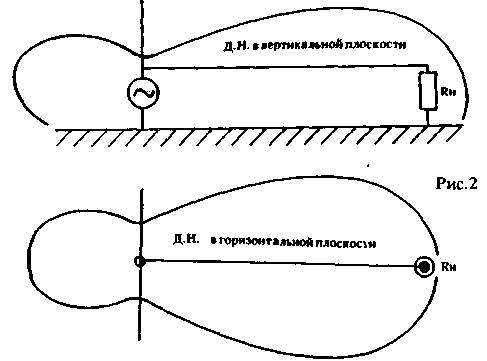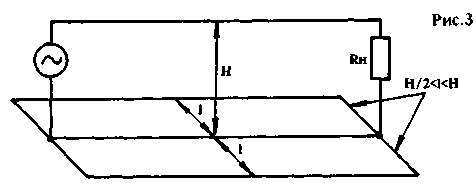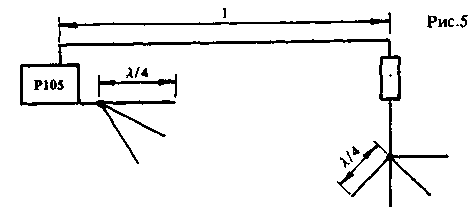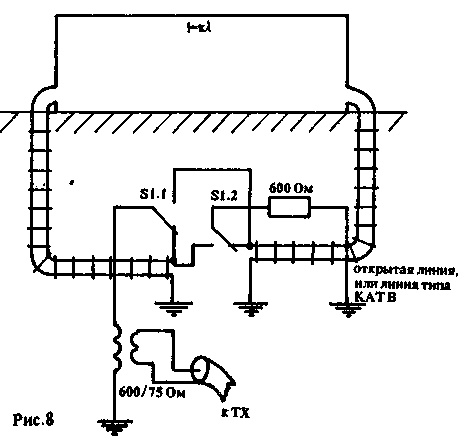Antenna Beverage or, as it is called, the antenna is a traveling wave (ABC), is widely used in professional radio. Most transoceanic QSO on 160 meter ham radio operators is carried out using the antenna Beverage an appointment. In the instructions to the radio R indicated that when using pin quarter-wave communication range between two similar stations are 2 km away, while using ABC - 4...5 km For a radio station R 105 communication range when using a quarter-wave whip antenna is 6 km away, while using ABC - 25 km Hopefully, these figures have been repeatedly proven by the military, will convince opponents antenna Beverage that it really is something there.
Antenna Beverage can work without rebuilding all Amateur bands with a minimum cost of its production and does not require setting when changing ranges. This feature attracts not only Amateurs, but also fans of long-distance transmission of broadcast stations.
1. THE IDEAL ANTENNA BEVERAGE
Classic ABC is a wire whose length is several times the wavelength, at which the antenna operates. It is loaded by a resistance equal to its characteristic impedance (Fig. 1). The height of the ABC suspension is from 1 to 5 m, depending on the frequency range in which it is used.

Input impedance high ABV and is equal to the characteristic impedance of the line formed by the wire constituting the fabric of the antenna, and the earth, which plays the role of the second wire. It is 400...600 Ohms. When hanging the ABC is not necessary everywhere to observe equal to the height of the suspension. On 160 meters effective antenna height of the suspension 3...5 m, and 10-meter range - height suspension of not less than 1 m.
The gain of ABC is equal to: G=Kh(L/l),where G is the gain coefficient; K is a coefficient that does not depend on the quality of manufacture ABC; L is the antenna length; l is the wavelength at which the antenna operates.
The longer the blade antenna, the higher the gain. Antenna Beverage receives vertically polarized wave incident at a small fragile. Such features have a surface wave, which is within sight, radio stations and long wave radio station, reflected from the ionosphere at a small angle.
In the horizontal plane max reception lies in the direction parallel to the blade antenna. When the perpendicular fall of the electromagnetic wave, nothing would induce in the antenna and in the fall at an angle, due to the addition induced in the antenna with different phases of voltages, the latter will compensate each other.

D. N. antenna Beverage is a narrow beam in the horizontal and vertical planes directed toward the load (Fig.2). At the excess length of the blade antenna on the wavelength, there is a fragmentation D. N. on the petals. The smaller posterior lobe of D. N., the better aligned the antenna to the load.
2. "EARTH" ANTENNAS BEVERAGE
The real work ABV largely depends on the quality of the land. It is best to lay a few "ground" wires from the load to the generator.

In practice, if you expect to use ABC to the transmission, to work effectively navigate at least 3 "ground" wires. One - under the blade antenna and the other two edges at a distance from it equal to (0,5...1) the height of the suspension leaf antenna (Fig.3). To enhance the effectiveness of these wires they should be or raised above the ground on a small height (5... 10 cm), or protected from corrosion if they are still lying on the ground.

When using ABC as a receiving antenna you can use only one "ground" wire. Sometimes reception centres instead of "ground" wire to use 10... 30 balances length of about 0.1 of the length of the antenna located at the end of the load and the transformer and buried to a depth of 10 cm (Fig.4). However, this does not save the wire for balances and in some cases increases the noise of the antenna due to the fact that it includes areas of land that can serve as a source of noise. Usually the specific source of noise is hard to define. It may occur due to the currents flowing in the earth's crust; may be due to the impact of industrial factors (overhead transmission lines, underground power lines, etc.).
At the receiving radio centers choose a location where no such effects, and in Your case it may well be that the QTH is located just near such a source of noise. Antenna Bevaix-reg are most exposed to such noise sources, especially without a "ground" wire under it. To the transmission of the antenna (Fig.4) will work unsatisfactory. This is due to the fact that in the circuit of the antenna included earth resistance R3, which is in General comparable to the antenna impedance and significantly reduces its efficiency. When using ABC to the admission this can be avoided, while receivers usually have a margin at the gain. But when working on the transmission efficiency is the most important indicator of the antenna.
We should not forget that the soil may freeze in winter to a considerable depth. This will significantly reduce the already low efficiency antenna Beverage (Fig.4). But often, for many reasons it is difficult or impractical to use the "ground" wire under the blade antenna. In this case we use the so-called "beam" antenna.
3. USE AS GROUND BALANCES QUARTER-WAVE
"Beam" antenna used for radio type P105 depicted in Fig.5. It is a wire of length 1 of about ten wavelengths to which the 400 Ohm resistor connected several balances the length of a quarter wave. Some balances and connected to the transceiver.

The current in the antenna occurs due to the displacement currents in the space between the balances. The current in the soil in this case is not critical. To increase the efficiency you need to strive to reduce the resistance of the system balances. When the wave impedance of the antenna 400... 600 Ohms is desirable to use at least 2 resonance balances on the load side and the supply side.
When using ABC in different ranges required for each band to use at least 2 resonance balances the length of a quarter wave for each of the ranges. The quarter-wave antenna with counterweights different from the classic ABC that has a continuous overlap in frequency.
4. LOAD ANTENNA BEVERAGE
Approximately 30 to 50% of the transmitter power is dissipated at the load, so it is essential that the load resistor was non-inductive.
In the design of transmitting antennas of Beverage you can use type resistors MLT-2 that are connected in parallel. Structurally, they made a ring. To protect the load from atmospheric influences its durable lacquer paint. It is desirable to prevent direct ingress of rain, by placing it under some cover. Usually for antenna Beverage use the load about 300...600 Ohms. To accurately set the impedance of the antenna is difficult, in practice this can be done merely by changing the load and dimension with the SWR of the antenna.
5. THE LENGTH AND EFFICIENCY OF THE ANTENNA BEVERAGE
It was stated above that the gain of ABC depends on its length, but the best results are obtained when the antenna length is a multiple of an odd number of lengths of half wavelengths. For successful operation, it should be not less than the wavelength at which the transmitter is functioning.
To determine efficiency, consider where the energy loss. First, load resistor RH. Secondly, the longer the antenna, the more radiation, the intensity of which increases with the height (H) ABC above the ground. Thus, the efficiency can be roughly defined by the formula:
Efficiency = 1 /RL*L/l*N/lЗ*K, where L is the length of the antenna;
l is the wavelength; K - coefficient of efficiency.
To increase the efficiency and improve the directional properties of ABC use them in parallel. Have them both in parallel and in series (Fig.6).

The efficiency of the antenna Beverage length of one wave with the height of the suspension to about 0,005 wavelength does not exceed 10 percent. Increasing the length of the antenna up to 6 wavelengths increases the efficiency to about 40 %, then the increase in efficiency is slowed down.
6. CHANGE D. N. ANTENNA BEVERAGE
One of the main disadvantages of ABC is that it is D. N. fixed. I was tested antenna option of Beverage with two transformers (Fig.7), which allows switching D. N. in two directions. When applying a DC voltage on the cable relay trigger and swap the mount points and power (used relay type of RAG). This antenna had a SWR of 1.8 in the entire frequency range from 1.8 to 30 MHz, the difference after changing the direction of radiation varied from 1 ...2 points for bass up to 6 points on the HF bands.

Meet recommendations for installing round antenna Beverage. In this case, the radiation pattern of this antenna is a circle, but the gain will be less than that of the dipole. If sufficient number of exposed lines or CAT can make easier to switch D. N. Diagram of the antenna for this purpose is shown in Fig.8. With this arrangement, the antenna open line must be raised off the ground. Increases the attenuation of the antenna and decreases its efficiency. But if the antenna is used for reception, such construction is acceptable. To switch the direction D. N. in this case, you can even use an ordinary tumbler.

7. ANTENNA INSTALLATION OF BEVERAGE
For the successful operation of ABC must be positioned correctly relative to foreign objects. Of course, the ideal setting is when there are no conductive objects. However, in practice this is rare. You should strive to ensure that no conductive objects in the home and, if possible, in the posterior lobe. As ABC radiates a vertically polarized wave, it is necessary to pay attention to vertical conductive objects. A very good option - installation on the edge of the roof of the house, when in the main lobe D. N. is free space. It is this ABC is used since 1989 on my station UZ3ZK. Often on the roof are the wires of the radio network and the phone, which may be parallel to Your ABC. Will they perceived as "earth", and they will be picking up large currents, which can lead to interference multi-program broadcasting and, possibly, TV, telephone communication. To eliminate this effect, it helps to lay the "ground" wire next to these wires. In all cases I've encountered, the bars were available "horns" to install it. The wire should be grounded next to each of the masts. In severe cases, may require the installation of several wires at a distance of 20 to 50 cm from each other.
In General, the antenna Beverage is one of the most unpretentious antennas. Clean the area within a radius of about 1 ...2 meters relative to the blade antenna will make it work. None of the neighbor of the antennas does not prevent it, as well as ABC has minimal impact on other antennas.
In Wuthering against ABC safe. Cloth it is grounded on two sides, so that even direct lightning strikes it will not lead to the defeat of the operator and the destruction of radio equipment. ABC is usually located below the other conductive items that provides additional protection from the storm. ABC does not accumulate 1 electrostatics, and this is especially noticeable when taken before a thunderstorm. It is possible to operate even during a thunderstorm. 1
Literature.
1. G. Z. Eisenberg, Shortwave antenna, M.: Radio and communication, 1985.
Author: I. Grigorov, Belgorod; Publication: N. Bolshakov, rf.atnn.ru






